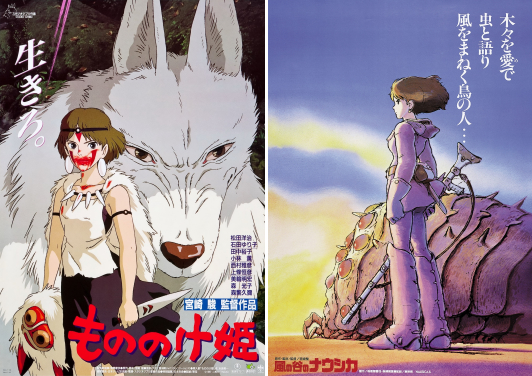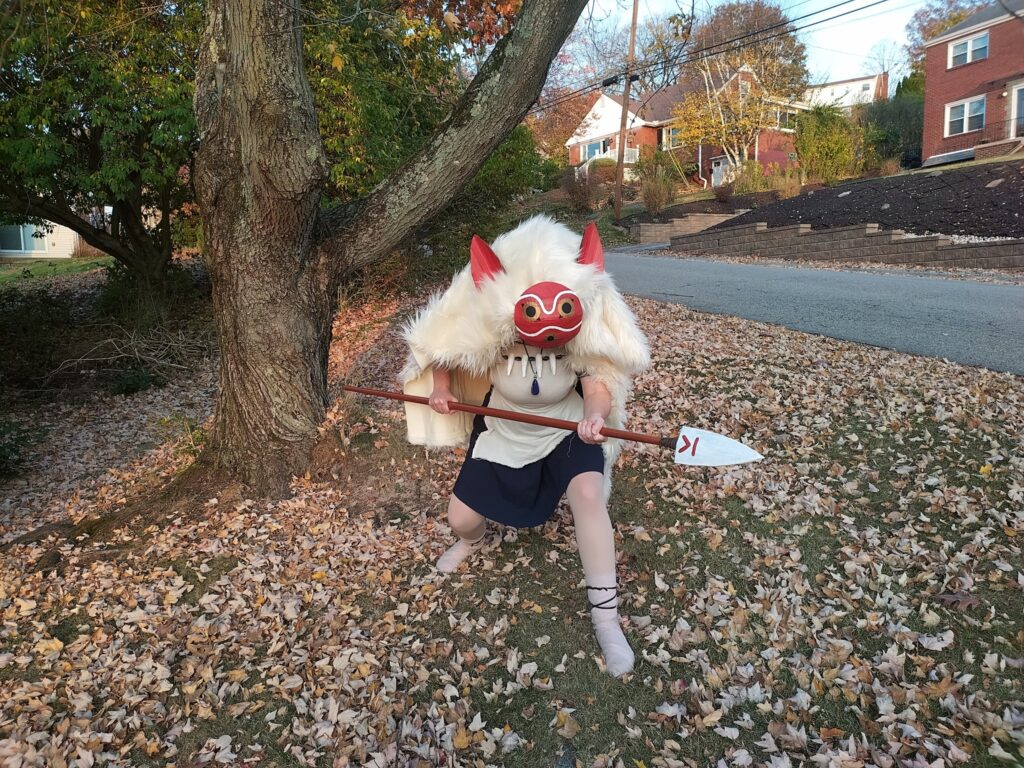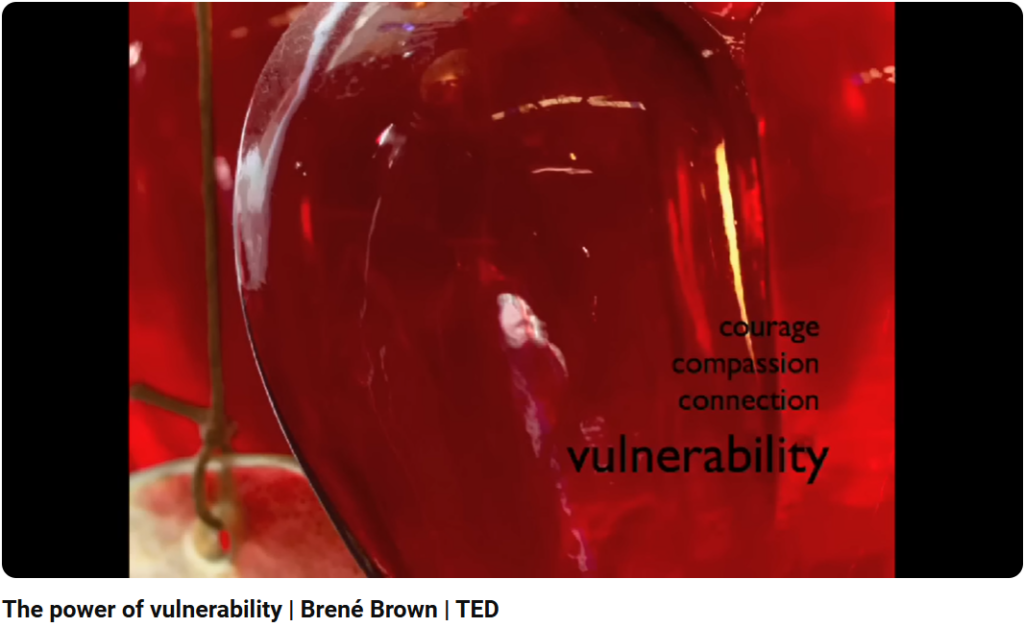Part 1
I try to avoid passive consumption of media, and YouTube is no exception: frequently I’ll fall victim to the “just one more video” trap, as the site’s algorithm succeeds in suggesting content that is of interest to me. That’s not to say there isn’t good content there. I very much enjoy long-form educational videos, particularly in the form of literary and film criticism, and I have justified many a video binge by turning such interesting content into a blog post. Personal failings and justification of behavior are, in fact, central to this exploration of what we call “strong” women, both inside and outside the universe of Hayao Miyazaki, [1] one of my favorite directors and co-founder of Japan’s Studio Ghibli. [2]
Depicting San
Halloween is my favorite holiday, and for years I had wanted to dress up as San, or “Princess Mononoke” – the girl raised by wolves who becomes infamous for her fight against the encroaching forces of industrialization that are destroying her forest home and its inhabitants. Although I am more measured in my approach to environmental defense, her passion, focused vision, and strength have always inspired me. And although that movie is probably my favorite from Studio Ghibli, I never watch it without trepidation because it is extremely difficult emotionally. Since 2024 was already an emotionally difficult year for me for many reasons, it felt like the right time to embrace San.

Image credits: [3],[4]
I have never repeated a Halloween costume, meaning that I wanted to do right by San, if this was going to be the year. However, it became an unintentional tradition of sorts during my childhood that my increasingly complex Halloween costumes were assembled at the last minute, sometimes involving all-nighters by my mom and/or my exceptionally talented artist of an aunt. Such was the case again this year: although I had decided months ahead of time, it wasn’t until Halloween week that I actually started construction. There were no all-nighters, but there were several very late nights of sewing a fur hood and cape, shaping a metal framework to support a mask and ears, and painting the iconic red mask.
Many of those late nights leading up to Halloween included a string of Miyazaki’s movies playing in the background, depicting inspiring characters and expansive philosophies about the world – things that reinforce the type of person I wish to be, especially in difficult times. And, of course, since my internet search history was full of movie stills and cosplay advice that would support my goal for a screen-accurate depiction of this titular heroine, I also started to get suggestions from YouTube that included video essays about Miyazaki I couldn’t refuse: why his heroines are different, [5] why his movie endings are different, [6] and how his own internal paradoxes contribute to a realistic level of complexity in the worlds he creates. [7]
Defining Strength
Miyazaki’s movies are known for, among other things, their strong female characters. However, while his characters are undoubtedly strong, they feel fundamentally different than those we see in more mainstream or western movies with “strong” female characters. A video essay that I rewatched several times in October alone unpacked what we’re really talking about when we talk about strength, particularly when it comes to women. The creator, who goes by “schnee” on YouTube posed that a typical list of attributes for a strong heroine could include words like independent, empowered, full of emotion, defies gender norms, and has agency. He then argued that while those fit more western examples of characters, they’re not the best fit for Miyazaki’s heroines.

Photo credit: Christian Korey
Our more mainstream female movie heroes (particularly in action movies) tend to be fearless (or trying to prove something), knowledgeable (bordering on all-knowing), successful at traditionally masculine tasks (often better than the male characters), and sexy (and subject to the male gaze via camera work). Meanwhile, in Miyazaki’s movies, the women feel fear but move forward in spite of it (demonstrating courage), have perspectives and knowledge limited to their own life experience (which expand over the course of the movie), eventually excel at tasks that are meaningful to them (but aren’t valued because of their association with traditional gender roles), and are absolutely not sexualized (or even depicted in a romantic relationship in most cases).
To summarize shnee’s argument, strong women in Miyazaki’s worlds are driven to fulfill a duty despite their fear; are low-ego, rarely self-conscious, and have nothing to prove to anyone else; are physically or ideologically isolated in rigid, polarized worlds; and are focused on priorities, not actions. They break barriers, not through shows of strength, but by projecting their inner harmony out into a damaged world (San is a notable exception to that trend); they are champions of love – not romantic love, but helping, healing, equality, and partnership. When it comes to gender dynamics, there is not a “boys vs. girls” antagonism – as a feminist and a pacifist, Miyazaki’s priority, as depicted through his movies, is harmony, not victory. [8]
Internalizing Lessons
Because I watched that video, YouTube’s algorithms sent me down a rabbit hole of how women are depicted in media (which is a fascinating topic, and I give myself a lot of leeway when it comes to bingeing videos if the content is educational). A video essay by “Vivifyre” argued that in “The Lord of the Rings” movies, [9] male characters display loyalty, empathy, humility, and honor, which make the audience love them; but when it comes to female characters, many writers see those same attributes as weaknesses (see Galadriel in “Rings of Power,” [10] who kicks ass, knows everything, has no weaknesses, and is completely unrelatable to the audience). Meanwhile that latter depiction of Galadriel is imposing, obnoxious, and consumed with the desire to prove herself, which are characteristics typically associated with villains. [11]

Image credit: [12]
I’m not saying that unrealistic female characters aren’t enjoyable – Sarah Connor [13] and Ellen Ripley [14] are badass and fun to watch (when I want an action movie) – but I think it’s detrimental for us not to acknowledge just how off-the-mark that definition of “strength” is in reality. It could be the result of male writers not being able to tap into the female experience or simply writing what they’d like to see in a heroic woman. (And don’t tell me great action movies can’t also have moving character arcs. [15]) Either way, that widespread trend robs audiences (particularly female audiences) of the opportunity to identify with the heroine. Best case scenario, if I see an attractive, talented, all-knowing, fearless woman on screen, I’m not going to relate to her; worst case scenario, audiences (especially young female audiences) will learn that imperfection equals weakness.
Vivifyre cited Clarice Starling [16] as an example of a well-written strong female character. Contrary to ROP’s Galadriel, Clarice is extremely courageous because she is extremely vulnerable – both physically and psychologically – throughout the entire movie. Vulnerability goes hand-in-hand with courage, and if anyone can attest to that, it’s researcher-storyteller Brené Brown, whose viral video on the subject now has over 22 million views (only about a quarter of which are mine). [17] Vulnerability (and everything that comes with it – patience, openness, courage) is a core attribute of Miyazaki’s heroines as they exhibit strength: in growing along their own character arcs, in helping others along theirs, and in working toward their goals in a way that prioritizes harmony over victory. And that is how I hope and try to live my life.
~
Strong women are complex and resilient, not flat and flawless, and we’ll touch more on that concept next week as we look more at these women and the worlds in which they reside.
Until then, who is your favorite Miyazaki heroine and why?
Thanks for reading!
[1] https://en.wikipedia.org/wiki/Hayao_Miyazaki
[2] https://en.wikipedia.org/wiki/Studio_Ghibli
[3] https://en.wikipedia.org/wiki/Princess_Mononoke
[4] https://en.wikipedia.org/wiki/Nausica%C3%A4_of_the_Valley_of_the_Wind_(film)
[5] https://www.youtube.com/watch?v=QCUKgF3aOsQ
[6] https://www.youtube.com/watch?v=Qf-oLlAPDsc
[7] https://www.youtube.com/watch?v=UG6XzB_J3IA
[8] https://www.youtube.com/watch?v=QCUKgF3aOsQ&t=16s
[9] https://www.imdb.com/title/tt0120737/
[10] https://www.imdb.com/title/tt7631058/
[11] https://www.youtube.com/watch?v=6Vbj88YYjhw&t=2s
[12] https://www.youtube.com/watch?v=iCvmsMzlF7o
[13] https://en.wikipedia.org/wiki/Sarah_Connor_(Terminator)
[14] https://en.wikipedia.org/wiki/Ellen_Ripley
[15] https://www.imdb.com/title/tt0095016/
0 Comments